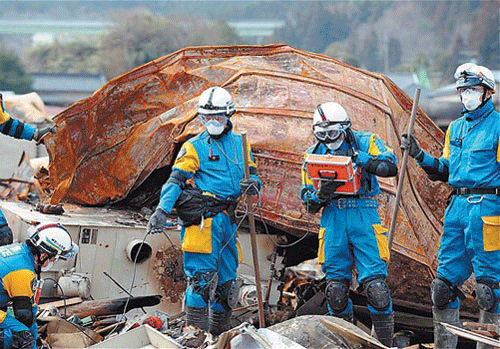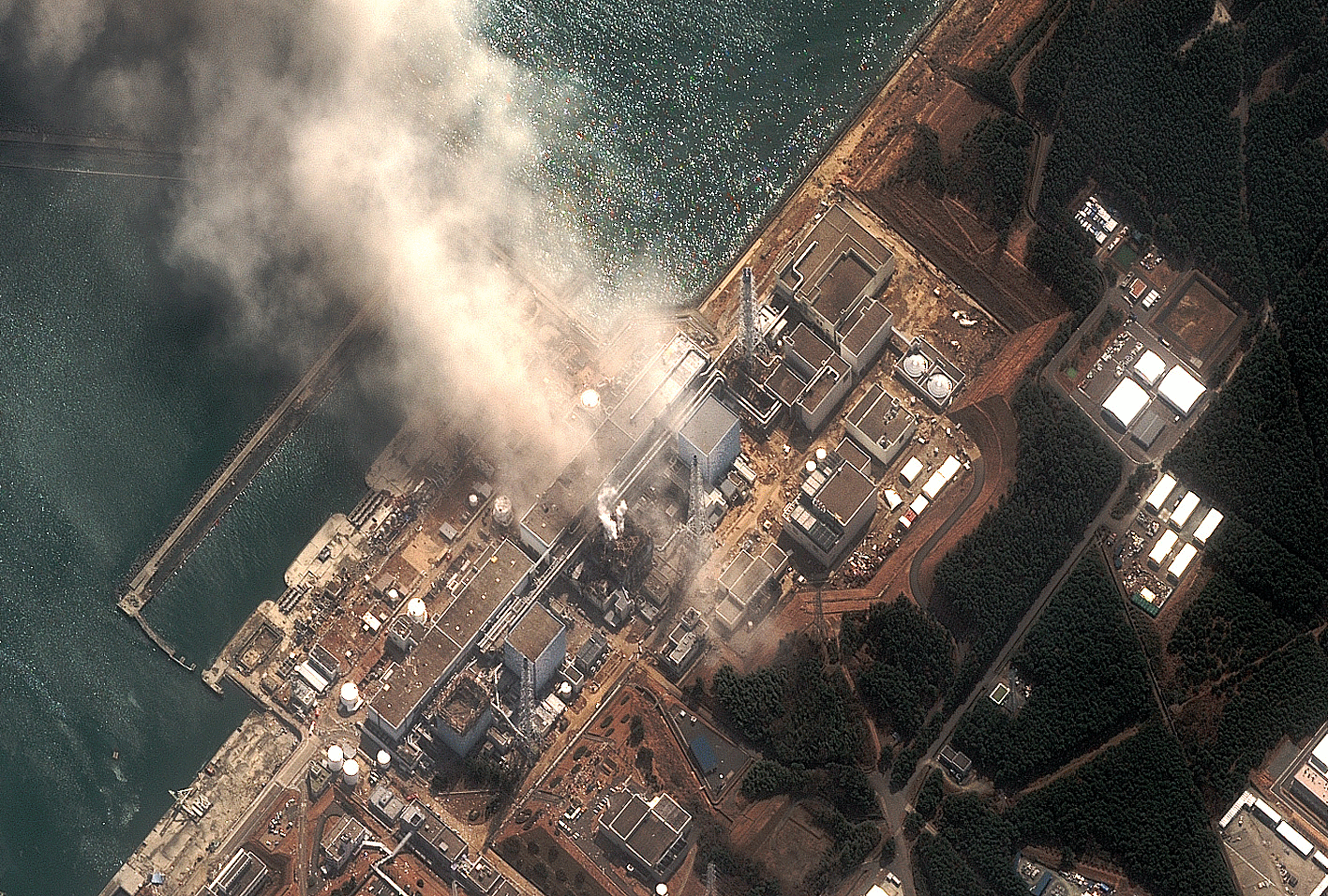Fukushima Nuclear Meltdown Three Years Later
Air Date: Week of March 14, 2014

Workers struggle to clean up and stabilize the damaged Fukushima reactors. (Los Alamos National Laboratory)
It’s been three years since a tsunami caused the meltdown of three nuclear reactors at Fukushima, Japan. Dale Klein, an adviser to the Tokyo Electric Power Company, tells host Steve Curwood that workers have stabilized the reactors but leaking radioactive water is still a problem.
Transcript
CURWOOD: From the Jennifer and Ted Stanley Studios in Boston, this is Living on Earth. I’m Steve Curwood. Legend has it that an ogress called Adachigahara once lived in the region of Japan that includes Fukushima, catching travelers and eating them. Today, radiation is the ogress that stalks the area, after a powerful earthquake and tsunami three years ago killed more than 18,000 people. The wall of water also smashed into the Fukushima nuclear power complex causing three reactors to melt down and release a massive plume of radioactive particles. Three years on, the fires are out but there are still massive amounts of radioactive water to contend with. Dale Klein is a former chairman of the US Nuclear Regulatory Commission and now advises the Tokyo Electric Power Company on the clean-up effort. Welcome to Living on Earth.
KLEIN: Well, thank you, Steve. It’s a pleasure to talk with you today.
CURWOOD: So, it’s been three years since the nuclear reactors - the three of them - melted down there in Japan. What’s the situation like on the ground in Fukushima?
KLEIN: You know, Steve, it’s a mixed bag. There’s pockets of success, and there’s pockets of failures. So I think, overall, the main radiation is being contained, and that is from the formerly molten fuel in the reactors and in the spent fuel pools. So on the big picture for big safety issues things are OK. The frustrating part is just the water management, the continuing leaks, doesn’t help with public trust and confidence, and it is a complicated site.
CURWOOD: Talk to me about the contaminated water there, the radioactive water. How much of it is leaking out now?
KLEIN: Not much is leaking out. They have had problems with some old contaminated waters in tunnels. They have had problems with occasional leaks from tanks. They just had one from a few weeks ago, and they have a massive amount of water. They had a lot of water that they had collected during the accident, so they have about 1,000 tanks of contaminated water, and the water accumulation rate is at about 400 tons a day due to in-leakage. They’re getting inflow from ground water that makes that accumulation of 400 tons a day, and that’s just not sustainable for the long term. They have to have a long-term integrated management program, and that’s what we’ve been working at.
CURWOOD: So what is the long-term solution at this point?

Most of the radioactive contamination from the Fukushima meltdown was blown out to sea. (Sandia National Laboratories)
KLEIN: The long-term is they’re going to...they have several filter systems up and running now where they’re removing the radioactive elements, and then putting that cleaned water into other tanks. The remaining isotope that they're going to have to determine what to do with is tritium. We know a lot about tritium. It's just one of the isotopes of hydrogen, so it's that infamous - how do you filter water out of water? You just can't do that economically. So it’s a very low-energy level. It does not accumulate in the body, but it’s a very emotional issue of what to do with the water after everything is filtered but it still has some tritium in it. So they’ll have to go through an educational process to let people understand what the risks are, how they intend to insure safety, and that they will have no environmental consequences if they ultimately do a controlled release into the ocean.
CURWOOD: Water into the ocean...what would the environmental impact be of dumping massive amounts of water contaminated with tritium, radioactive tritium?
KLEIN: It would not be a problem. The IAEA has looked at that issue, the current regulatory body is looking at that issue, so there are standards for what safe levels of tritium are. And so they just need to go through a process to understand how they can ultimately, safely, with no impact on the environment release the tritiated water.
CURWOOD: So overall, how has the meltdown incident affected the people who live in the Fukushima area?
KLEIN: The area around the reactors themselves is like a ghost town. It’s very sobering to go through that site and see once thriving villages that had to be evacuated. It is very traumatic, I think, for those people who had to be removed from their homes, and the sooner they can safely return, I think the better it will be for the local citizens. The government is proposing to let people move closer around April of this year, so some of the areas look quite nice, the fields are clean, the rice paddies are back to normal conditions, the homes are rebuilt. As you approach the plant itself, there’s a lot of structural damage from a lot of the homes. And so you’ll see a lot of broken glass. Those areas have considerable damage, as well as higher levels of contamination, and those will just be isolated for some period of time.
CURWOOD: What have been the health effects so far?
KLEIN: Interestingly enough, the IAEA did a very comprehensive study, and from all the data that they’ve looked at and all the projections, it looks like there will be very, very little health impacts from the radiation. People were evacuated in a timely manner, most of the radiation that did escape went out to sea. From what we know today, even if there was radiation released, it will have a minimal impact on people’s health.
CURWOOD: What about the workers who went in to deal with the problems of the meltdowns?
KLEIN: From the measurements that we’ve seen, very few workers received very high levels of radiation. They also have talked about the “Fukushima 50”, the 50 workers that were there for an extended period of time. But from the data that they seen so far, there have been no adverse health effects from those Fukushima 50 workers.
CURWOOD: Nobody’s sick?
KLEIN: No one is sick. No cancer rates so far.
CURWOOD: Early on, one might see health effects on thyroid from the release of radioactive iodine. Those effects show up pretty early. What do you see along those lines?
KLEIN: We have not seen significant impacts from the iodine. The good news is people were evacuated. It was not the same situation that we saw in Chernobyl where it was covered up for a long period of time, and people were unnecessarily exposed to the Iodine-131. So they have not seen increases in thyroid cancer.
CURWOOD: By the way, you said much of the initial plume of these meltdowns went out to sea. Does that mean really more radioactive activity went away from the populated areas?
KLEIN: Yes, it did. Most of the radiation...the wind was blowing towards the east. So most of that radiation was carried away from the villages and the population centers.
CURWOOD: Dale Klein is a former chairman of the US Nuclear Regulatory Commission, and he’s on assignment now in Fukushima, Japan, advising the Tokyo Electric Power Company on the cleanup effort. Thanks so much for taking the time with me today.
KLEIN: Thank you, Steve. It was my pleasure.
Links
Check out this mini-documentary on the health impacts of Fukushima radiation
Living on Earth wants to hear from you!
Living on Earth
62 Calef Highway, Suite 212
Lee, NH 03861
Telephone: 617-287-4121
E-mail: comments@loe.org
Newsletter [Click here]
Donate to Living on Earth!
Living on Earth is an independent media program and relies entirely on contributions from listeners and institutions supporting public service. Please donate now to preserve an independent environmental voice.
NewsletterLiving on Earth offers a weekly delivery of the show's rundown to your mailbox. Sign up for our newsletter today!
 Sailors For The Sea: Be the change you want to sea.
Sailors For The Sea: Be the change you want to sea.
 The Grantham Foundation for the Protection of the Environment: Committed to protecting and improving the health of the global environment.
The Grantham Foundation for the Protection of the Environment: Committed to protecting and improving the health of the global environment.
 Contribute to Living on Earth and receive, as our gift to you, an archival print of one of Mark Seth Lender's extraordinary wildlife photographs. Follow the link to see Mark's current collection of photographs.
Contribute to Living on Earth and receive, as our gift to you, an archival print of one of Mark Seth Lender's extraordinary wildlife photographs. Follow the link to see Mark's current collection of photographs.
 Buy a signed copy of Mark Seth Lender's book Smeagull the Seagull & support Living on Earth
Buy a signed copy of Mark Seth Lender's book Smeagull the Seagull & support Living on Earth

